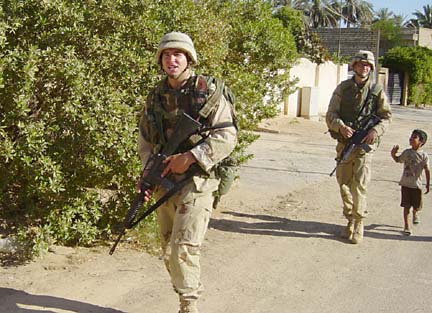
US ARMY PHOTO BY CAPT. CHRISTOPHER OWEN
Capt. Chris Brown, above left, and a soldier from the 25th Infantry Division pose with some Iraqi children and a picture of President Bush and Prime Minister Tony Blair.
War gets personal for Schofield soldiers
as they see the country's economic divide
Christopher Owen was just 19 -- an Army brat who barely made it out of a military high school in Germany -- when he joined the Army and found himself as a machine gunner on a Bradley fighting vehicle in Iraq 13 years ago.
"I was a real punk then," said Owen. "I graduated 113 out of 117 students. I wanted a break, so I enlisted in the infantry to straighten myself out."
After serving for two years, which included fighting for three months in the Iraqi desert during the 1991 Gulf War with the 24th Infantry Division, Owen left the Army and enrolled in Southwest Texas State University in San Marcos, Texas.
"I always wanted to be an officer; so I knew I had to go college," said Owen, who continued his military affiliation by first joining the Texas Army National Guard and later enrolled in the college's ROTC program.
Twelve years later, Owen, 31, found himself back in Iraq and in another war. This time he was an officer -- a member of Headquarters and Headquarters Company of the 25th Infantry Division -- and assigned to the 101st Airborne Division.
This time as a member's of the division's tactical operations center, Owen ended up leading patrols into Baghdad, Babylon and other cities to the south.
"I passed through the same sectors I was in with the 24th Division in 1991," said Owen as he recounted his latest Gulf War experience.
US ARMY PHOTO BY CAPT. CHRISTOPHER OWEN
Pvt. Javier Snider from 1st Battalion, 27th Infantry, and a fellow soldier from the 101st Airborne Division patrol in central Baghdad.
However, this time the battlefield was different: open desert in the first Gulf War versus cities or towns in the second one.
All the urban warfare training Owen has received during his 13 years in uniform didn't quite prepare him for the actual close-quarters combat.
"You can't really return fire," said Owen. "You don't know where the shots are coming from. There were shops, stores and civilians everywhere."
Owen was one of 107 Schofield Barracks soldiers from the 25th Infantry Division who volunteered to fight in Iraq. His second front-line tour earned him the privilege of attaching a star to the combat infantryman's badge he earned for fighting in the first Gulf War and a combat shoulder patch.
The first group of Tropic Lightning soldiers left Schofield Barracks on March 11, with the second batch following 11 days later. All but 10 of these soldiers returned home on June 5.
They were all first sent to Fort Sill, Okla., to ensure they had the necessary shots and equipment and then were deployed to Kuwait, where they met other volunteers, including Army National Guard soldiers and reservists, and waited for the assignment as "casualty replacements" or "fillers" for units like the 82nd Airborne Division of the 101st Airborne Division or the 3rd Infantry Division. Since there were no major losses in any of those units, the soldiers returned to Schofield Barracks as soon as the war was over.
Some, like Staff Sgt. Avant Pearson and Spc. Matthew Nelsen, were given a day's notice and a week later found themselves in combat. Both were assigned to the 101st Division.
Pearson, 30, said he expected "a longer fight. I was surprised how short the war lasted."
Like most of the soldiers, who deployed to Iraq, this was their first taste of combat.
"But this is what you practice for," said Sgt. Kristien Yochum, from Waianae. "After going through all the drills you finally get into the game. That is why 90 percent of us joined the Army."
Capt. Scott Greenblatt, who was attached to the 82nd Airborne Division, added, "We were prepared to leave for one year."
Staff Sgt. Donald Workman, a six-year Army veteran, said he didn't expect to see poverty as bad as it was in Iraq contrasted with the wealth of some Baath Party officials.
"All the money was wasted in self-portraits and statues (of Saddam Hussein)," said Workman, 30, who was with the 101st Airborne Division. "Everything revolved around him."
"We found a warehouse filled with 200 cars," Owen added. "There were Ferraris, Lamborghinis, SUVs ... and on either side of the compound lived dirt-poor farmers. People with tons of money living next to squalor. They flaunted it."
Greenblatt, who is a Jew, said his mother was born in Baghdad, but his parents tried several times to escape from Iraq and finally succeeded in 1951. "Being there shed a little more light on the challenges they faced," said Greenblatt, who was raised on Long Island.
Owen said this time around there a sense of "job satisfaction."
"The last time there was no interaction with the civilian population," Owen said. "The reception this time was unreal. It made you feel like a million bucks."
He believes the American people don't really realize the true feelings of the people of Iraq.
"Literally the streets were lined with people cheering and clapping," Owen said. "They were giving us flowers and water and pulling us into their homes to eat with them. Maybe 5 percent of the country was ticked off and killing our soldiers. But the majority of the country wanted us there ... They were extremely happy ... The American people cannot comprehend or understand what happened there."
Once back, all of Tropic Lightning soldiers were given 30 days of leave.
But if the call comes for volunteers, they say they are ready.
"If it's tomorrow," said Greenblatt, "we're ready."
Hawaii military links and information


